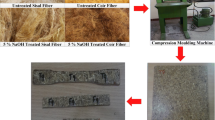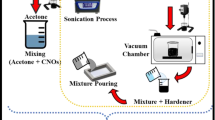Abstract
The silicon carbide (SiC) reinforced epoxy composites has evidenced their reputation as advanced composite material in domain of strength and durable nature. But, presence of SiC particles as reinforcement in epoxy composites wanes the machinability by increasing tool wear in conventional drilling process. For the reduction in tool wear and improvement in machinability, it becomes necessary to use non-conventional machining method which can elude direct tool-composite interaction. In domain of non-conventional machining methods, the electrochemical discharge machining (ECDM) process is emerging as potential contender for machining of nonconductive, hard and brittle fibrous materials. In this paper, artificial neural network-based hybrid model was generated for prediction and optimizing material removal rate (MRR) and taper during ECDM of SiC reinforced epoxy composites. The input parameters considered for the process were selected as voltage, electrolyte concentration, inter-electrode gap and duty factor whereas MRR and taper were obtained as response parameters. The experimentation was performed based on response surface methodology (RSM) using central composite design. RSM and ANN models were used to predict the MRR and taper during ECDM. The input parameters were optimized for higher MRR and minimum taper using desirability function. The obtained results for optimal solution were validated with the neural network model. The validation exemplifies the influence that machining methods focussed on artificial intelligence have on optimizing progressions.
Similar content being viewed by others
References
Sathish Kumar TP, Naveen J, Satheesh KS (2014) Hybrid fiber reinforced polymer composites – a review. J Reinf Plast Compos 33:454–471
Antil P, Singh S, Manna A (2017) Glass fibers/SiCp reinforced epoxy composites: effect of environmental conditions. J Compos Mater 52(9):1253–1264
Antil P (2018) Experimental analysis on Wear behavior of PMCs reinforced with Electroless coated silicon carbide particulates. Silicon. https://doi.org/10.1007/s12633-018-9995-9
Latha PS, Rao MV (2018) Investigation into effect of ceramic fillers on mechanical and Tribological properties of bamboo-glass hybrid Fiber reinforced polymer composites. Silicon 10(4):1543–1550
Antil P, Singh S, Manna A (2018) SiCp/glass fibers reinforced epoxy composites: Wear and Erosion behaviour. Indian J Eng Mater Sci 25(2):122–130
Rahamathullah I, Shunmugam MS (2014) Mechanistic approach for prediction of forces in micro-drilling of plain and glass-reinforced epoxy sheets. Int J Adv Manuf Technol 75:1177–1187
Singh S (2016) Study of drilling behavior of aluminium 6061 metal matrix composites using taguchi’s methodology. Int J Mach Mach Mater 18(04):327–340
Kurafuji H (1968) Electrical discharge drilling of glass. I Annals of CIRP 16:415–419
Antil P, Singh S, Manna A (2018) Effect of reinforced SiC particulates of different grit size on mechanical and Tribological properties of hybrid PMCs. Material Today Proceedings 5(2):8073–8079
Subramanian M, Sakthivel M, Sudhakaran R (2014) Modeling and analysis of surface roughness of Al7075-T6 in end milling process using response surface methodology. Arab J Sci Eng 39:7299–7313
Canakci A, Ozsahin S, Varol T (2014) Prediction of effect of reinforcement size and volume fraction on the abrasive wear behavior of AA2014/B4CpMMC5 using artificial neural network. Arab J Sci Eng 39:6351–6361
Antil P, Singh S, Manna A (2017) Electrochemical discharge drilling of SiC reinforced polymer matrix composite using Taguchi's Grey relational analysis. Arab J Sci Eng 43(3):1257–1266
Katal N, Narayan S (2017) Optimal QFT controller and pre-filter for buck converter using multi-objective genetic algorithm. Int. J Swarm Intell 3:192–214
Onwubolu G, Clerc M (2004) Optimal path for automated drilling operations by a new heuristic approach using particle swarm optimization. Int J Prod Res 42:473–491
Montgomery DC (1997) Design and analysis of experiments4th edn. Sons, John Wiley and
Feng L, Wei X, Zhao YZ, Jing Z, Zheng T (2012) Analytical prediction and experimental verification of surface roughness during the burnishing process. Int J Mach Tools Manuf 62:67–75
Sagbas A (2011) Analysis and optimization of surface roughness in the ball burnishing process using response surface methodology and desirabilty function. Adv Eng Softw 42(11):992–998
Zain AM, Habibollah H, Safian S (2010) Prediction of surface roughness in the end milling machining using artificial neural network. Expert Syst Appl 37(2):1755–1768
Erzurumlu T, Hasan O (2007) Comparison of response surface model with neural network in determining the surface quality of moulded parts. Mater Des 28(2):459–465
Pilkingtona JL, Prestonb C, Gomesa RL (2014) Comparison of response surface methodology (RSM) and artificialneural networks (ANN) towards efficient extraction of artemisininfrom. Ind Crop Prod 58:15–24
Kiran AP, Pragnesh KB (2016) A comparative study of the RSM and ANN models for predicting surface roughness in roller burnishing. Procedia Technol 23:391–397
Lipinski D, Balasz B, Rypina L (2018) Modelling of surface roughness and grinding forces using artificial neural networks with assessment of the ability to data generalisation. Int J Adv Manuf Technol 94:1335–1347
Song H, Ren G, Dan J (2018) Experimental study of the cutting force during laser-assisted machining of fused silica based on artificial neural network and response surface methodology. Silicon. https://doi.org/10.1007/s12633-018-0010-2
Vijayabhaskar S, Rajmohan T (2018) Experimental investigation and optimization of machining parameters in WEDM of Nano-SiC particles reinforced magnesium matrix composites. Silicon. https://doi.org/10.1007/s12633-017-9676-0
Kumar V, Singh H (2019) Rotary ultrasonic Drilling of Silica Glass BK-7: microstructural investigation and process optimization through TOPSIS. Silicon 11(1):471–485
Kansal HK, Singh S, Kumar P (2005) Parametric optimization of powder mixed electrical discharge machining by response surface methodology. J Mater Process Technol 169:427–436
Cheok CY, Chin NL, Yusof YA, Talib RA, Law CL (2012) Optimization of total phenolic content extracted from Garcinia mangostana Linn hull using response, surface methodology versus artificial neural network. Ind Crop Prod 40:247–253
Madadlou A, Emam-Djomeh Z, Mousavi ME, Ehsani M, Javanmard M, Shee-han D (2009) Response surface optimization of an artificial neural network for predicting the size of re-assembled casein micelles. Comput Electron Agric 68:216–221
Antil P, Singh S, Manna A (2019) Experimental investigation during electrochemical discharge machining (ECDM) of hybrid polymer matrix composites, Iranian journal of Science & Technology (transactions of mechanical engineering), Springer: https://doi.org/10.1007/s40997-019-00280-5
Manna Alakesh and Narang Vivek (2012) “An experimental investigation during micro machining of E glass fibre epoxy composite on developed electrochemical spark machining setup” International Journal of Manufacturing, Materials, and Mechanical Engineering (IJMMME), 2(2), pp.15
Deringer G, Suich R (1980) Simultaneous optimization of several response variables. J Qual Technol 12:214–219
Sharma V, Kumar V (2016) Multi-objective optimization of laser curve cutting of aluminium metal matrix composites using desirability function approach. J Braz Soc Mech Sci Eng 38:1221–1238
Acknowledgements
The Author would like to thank Sophisticated Analytical Instrumentation Facility (SAIF), Panjab University, Chandigarh, India for providing their SEM/FE-SEM lab support for surface evaluation of test specimen(s).
Author information
Authors and Affiliations
Corresponding author
Ethics declarations
Conflicting Interests
The author declared no potential conflicts of interest with respect to the research, authorship, and/or publication of this article.
Additional information
Publisher’s Note
Springer Nature remains neutral with regard to jurisdictional claims in published maps and institutional affiliations.
Rights and permissions
About this article
Cite this article
Antil, P. Modelling and Multi-Objective Optimization during ECDM of Silicon Carbide Reinforced Epoxy Composites. Silicon 12, 275–288 (2020). https://doi.org/10.1007/s12633-019-00122-8
Received:
Accepted:
Published:
Issue Date:
DOI: https://doi.org/10.1007/s12633-019-00122-8




